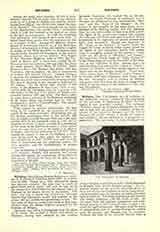

Bologna, GIOVANNI DA, Flemish Renaissance sculptor, b. at Douai, in Flanders, about 1524; d. at Florence in 1608. Vasari gives little information about this eminent sculptor. He calls him “a youth of great talent and of spirit” and says he was one of the competitors with Cellini for the colossal figure of Neptune in his chariot drawn by sea horses. The duke, who was to decide the competition, although assured that Giovanni’s model was superior to the others, did not confide the undertaking to him. We can judge of what he would have made of that commission from the bronze Neptune prepared for the fountain at Bologna.
Giovanni was called Il Fiammingo from the place of his birth. He studied in Rome and settled in Florence, having been adopted by the wealthy Bernardo Vecchietti, who treated him as his son. He was thoroughly Florentine in sentiment, and in Florence are preserved his two masterpieces, “Mercury” and the “Rape of the Sabines”. In the former, in the Bargello, he has come nearer to expressing swift, flashing motion and airy lightness than has any other artist of that or a later period. The figure of the youth with winged feet, holding the caduceus, and borne aloft upon a head of Aeolus, is masterly in its expression of earnest purpose and light, easy movement. Hardly less important is the “Rape of the Sabines” in marble, under the Loggia dei Lanzi, in which Count Ginori posed for the figure of the triumphant youth who carries away a struggling woman in his embrace. Other works are the group of “Hercules and Nessus”, the equestrian bronze figure of “Duke Cosimo I” in the Piazza Signoria and the bas-relief of the doorway of the Cathedral of Pisa. Besides these, he executed more than one crucifix, a figure of “Diana”, another of “Venus”, and four syrens similar to the larger ones on the Bologna fountain. Vasari mentions a bronze figure of “Bacchus”, and a “Samson” in combat with two Philistines, both larger than life size. Giovanni’s work is marked by freedom and grace, while free from the fault of exaggeration which so injures much of the sculpture of the very late Renaissance.
GEORGE CHARLES WILLIAMSON

